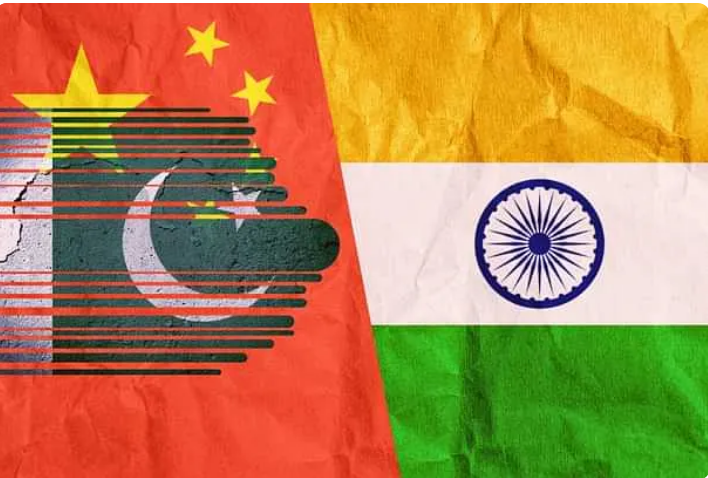
China cannot strike, cannot embrace, and cannot ignore India, so it acts through Pakistan. India responds not in rage, but with a methodical siege that tightens silently.
The blueprint of the Pahalgam attack has been different. This was not a routine militant operation, nor a familiar skirmish at the margins of Kashmir’s insurgency. It was an act of exceptional brutality, deliberate scale, and unmistakable strategic design.
Twenty-six civilians, almost all Hindu tourists, were methodically identified through religious questioning, forced recitations, physical checks, and then shot dead. The attackers used AK-47s and M4 carbines, wore military uniforms, and struck with precision in a remote tourist meadow.
Strikingly, they did not harm women or children, even when provoked. Instead, they told the surviving women to go and “tell Modi.”
The attack was claimed by TRF, a front organization linked to the Pakistan-based Lashkar-e-Taiba. Investigative agencies have also revealed that one identified Pakistani terrorist behind the Pahalgam massacre is a former para commando of the Pakistan Army’s Special Forces. The involvement of Pakistan is apparent.
If the objective was to provoke India – both its government and its people – the perpetrators could not have orchestrated it more effectively. The question is, why did Pakistan choose to do it?
Suicidal Pakistan?
The pattern of Indian responses to past attacks, especially under the current government, suggests that any retaliation this time would likely be severe. Yet Pakistan carried it out in a way designed to trigger maximum national outrage.
Some analysts might argue that this is a familiar diversionary tactic. When economic conditions worsen, authoritarian or military-controlled regimes often seek external enemies to unify a disillusioned population. On the surface, that explanation may seem plausible.
However, Pakistan’s situation today goes well beyond typical economic distress. Pakistan is near financial collapse, with depleted reserves and political fracture. It lacks even the minimum economic foundation to sustain a medium-term conflict without significant external support.
That brings us to the deeper question. If war is financially suicidal for Pakistan, and provocation was certain to invite retaliation, then why did it proceed anyway?
Beijing’s India Dilemma
Lately, it has seemed as though India and China have been entering a more stable and even friendly phase. Diplomatic exchanges have resumed, and symbolic gestures like the Kailash Mansarovar Yatra have been restored.
But beneath this surface of civility lies a far deeper dilemma for Beijing. China finds itself grappling with a rising India it cannot ignore and cannot contain. It is itching to act, but uncertain about what action would serve its interests without backfiring.
For much of the twenty-first century, the India-China relationship has been asymmetrical. China had already arrived, while India was still aspiring. This framing became especially dominant after 2010, as China surged ahead in trade, technology, and infrastructure.
But this began to shift after Doklam in 2017, when India stood firm in a protracted standoff and refused to back down. China was forced to reckon with a neighbour that was not only assertive but increasingly capable. The situation escalated further during the Galwan Valley clash, where India showed both operational readiness and political will.
Then came the economic divergence post-COVID. India’s recovery has been sharp and broad-based, while China’s has been lethargic and uneven. Despite massive stimulus, China remains mired in deflation, showing signs of deep structural problems. With weak demand, firms in a debt crisis, and an ageing, overleveraged economy, China is in trouble.
Simultaneously, the India-China pairing has become more common in global discourse. No longer is India seen as a regional player; it is now mentioned frequently as an alternative to China in headlines, boardrooms, policy discussions, and key decisions.
The shift accelerated dramatically in 2025, especially after the United States launched its trade war. While both economies face consequences from such a conflict, the pain is much higher for exporters like China. Chinese supply chains are showing signs of fracture, inventories are building up, and price collapses are deepening the deflation spiral.
Crucially, what enables the United States to wage this tariff war is the confidence that India exists as a viable scale alternative. India provides the strategic depth Washington needs to sustain pressure on Beijing. This dynamic has been picked up even in Chinese media outlets, where mentions of India in the context of trade, supply chains, and geopolitical balance have surged. The U.S. is trying to box in China, and the India pivot is central to that.
In any other context, this would make India an obvious target for Chinese containment. A rising competitor at your doorstep, empowering your global rival. But here lies Beijing’s challenge.
India’s Global Relevance
India is not just rising; it is doing so independently. It has maintained strategic autonomy, refusing to be bound to any single bloc, including the Western alliance. A direct confrontation with India would carry steep costs for China.
It would push India further into the embrace of the United States, cement the India-China binary in global perception, and almost certainly result in a military stalemate, one that would be interpreted as a defeat for Beijing. Galwan and Doklam already revealed China’s limits. Another confrontation might make that reality undeniable.
Most importantly, if China truly wants to build an alternative to the United States-led financial and trade architecture, through BRICS, alternate payment systems, or a non-dollar reserve strategy, it needs India. Without India, any attempt to move global commerce free from U.S. hegemony or reorient the monetary order will lack credibility and scale. Russia understands this. China does too. That is why it cannot afford a full rupture.
And yet, China cannot allow India’s rise to proceed unchallenged. For China, doing something or doing nothing are both risky.
India is a rising rival that threatens China’s position, but it is also an indispensable partner in any realistic plan to escape the grip of Western economic dominance. China cannot strike, cannot embrace, and cannot ignore.
And so, enters the Pakistan proxy.
China’s Footprint in Pahalgam
In this strategic impasse, Pakistan becomes an invaluable tool for China. There is mounting evidence that suggests China is not just backing, but directly sponsoring Pakistan’s aggression.
The Pahalgam attack revealed sophisticated, foreign-backed coordination. Reports have indicated that terrorists were equipped with banned Huawei satellite phones and sophisticated Chinese “Ultra Set” encryption technology specifically designed to evade detection. These specialized devices are reportedly custom-made by Chinese companies for Pakistan’s military, operating on radio frequencies connected to control stations across the border. The communications are reportedly compressed and transmitted through Chinese satellites to servers in Pakistan.
The advanced nature of this technology and its specialized military application strongly suggests Chinese authorities were aware of its deployment by terrorist groups targeting Kashmir.
Diplomatically, China’s reaction has been to back Pakistan strongly, undermining India’s diplomatic efforts at the United Nations and refusing to label the attack as terrorism. Foreign Minister Wang Yi affirmed China’s “ironclad” support for Pakistan and called for an “impartial investigation,” despite clear evidence linking the attackers directly to Pakistan’s military elite. Additionally, China strategist Victor Gao has indicated that China would “defend Pakistan’s sovereignty” if threatened.
India’s Response: A Strategic Siege
Nearly every major power quietly wants an India-Pakistan war. For China, it would mark a reversal of India’s rise as a counterweight and bring back the outdated India-Pakistan hyphenation.
For the United States, a drawn-out conflict would weaken India’s negotiating leverage and ensure New Delhi remains more compliant in the global order.
Even Russia, though aligned with India, has no reason to want the burden of a geopolitical crisis to remain its alone, as it has in Ukraine. The timing of Putin’s call to Prime Minister Modi, coming only after India’s Defence Minister pulled out of Russia’s Victory Day Parade, indicates the same.
And Pakistan certainly wants war. More precisely, an immediate one. It has been escalating even after the incident. There is credible belief that it has been paid to trigger conflict, and without war, it cannot activate the wartime economy that its sponsors have pledged to underwrite.
But mobilising troops is expensive, and maintaining alertness drains both morale and money. The longer India delays, the more Pakistan bleeds without being able to shoot. That is why it continues to provoke, from capturing a BSF jawan to amplifying war rhetoric, hoping India will lose patience. And it will likely keep provoking and acting to get India into a war.
But the world still underestimates India’s geopolitical smartness. It is not without reason that India has kept both the Russia-China camps and the Western camp on tenterhooks and has been manoeuvring them effortlessly for some time now. From BRICS to Quad, it is a member of all geopolitical alliances. Everyone needs India on their side for their own geopolitical ends. India is neither fully aligned nor isolated. It walks the razor’s edge and emerges unscathed.
New Delhi’s response is not impulsive at all. It is a methodical siege. The water pressure on Pakistan has quietly increased. Few realize that India has been constructing dams on the Indus tributaries since 2016, enhancing its capability to influence downstream flow. This affects not only agriculture, but also electricity and food security.
The Indian military remains in a forward posture. Cabinet committee meetings are held frequently, and the air of impending retaliation is strongly cultivated. Pakistan’s army remains on edge, burning through reserves, caught in constant high-alert mode.
Meanwhile, India’s diplomatic corps is fully engaged. This global pressure tires not only Pakistan, but also its supporters. For China, already struggling with a tariff war and a collapsing economy, the added burden of managing Pakistan’s strategic weight for long is an unwelcome distraction. The right levers are being pulled in the U.S., Europe, and Russia as well. India is laying siege not only on the border but in the global system, as only it can.
The response will undoubtedly come. There may well be a sharp military action. But it will arrive when Pakistan’s morale is broken, when the weight of sleepless nights, water and food shortages, economic drain, and constant mobilization has turned Pakistan’s military posture into a brittle shell.
When that moment comes, the Indian strike will not just land. It will shatter. It will be quick. It will be decisive. The opponent will fold like paper.
The world will get what it wants, but on the terms decided by India.
And it will remind the world that the greater power chooses its moment. Not in reaction, but on terms that ensure victory.
Postscript: Operation Sindoor.
In the early hours of 7 May, India conducted a precise, non-escalatory strike named Operation Sindoor, targeting terrorist camps at nine locations across Pakistan and PoK. The operation demonstrated India’s strategic maturity by deliberately avoiding civilian and military installations.
However, similar restraint from Pakistan is unlikely. Despite Pakistan’s severe economic and political troubles, it is expected that retaliation will eventually follow. It can be direct or indirect via terrorist proxies, potentially targeting civilian or military assets.
The aim of the Pahalgam attack was to induce a war, and that still remains the case. Pakistan and its backers clearly seek a broader conflict with India, and such provocations are unlikely to cease until their goal is achieved.






